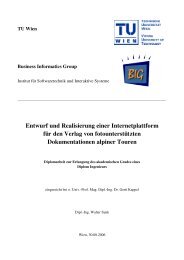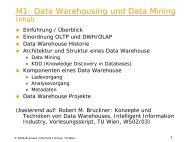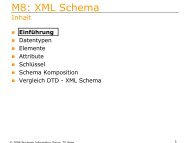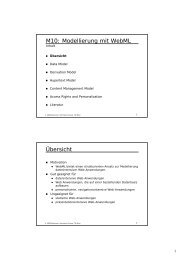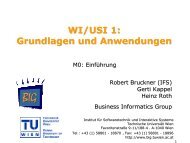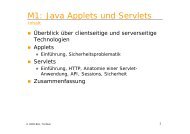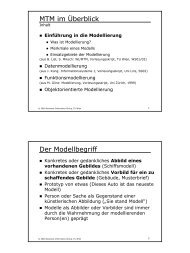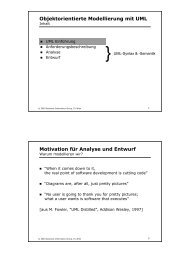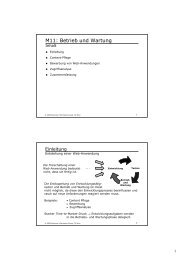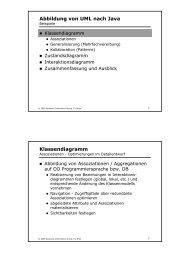Ph.D. Thesis - Business Informatics Group
Ph.D. Thesis - Business Informatics Group
Ph.D. Thesis - Business Informatics Group
Create successful ePaper yourself
Turn your PDF publications into a flip-book with our unique Google optimized e-Paper software.
1.1.1 Tool Integration<br />
Chapter 1 Introduction<br />
Research in tool integration has been a "hot" topic since the Stoneman Model was proposed<br />
at the end of the 70’s and summarized by Brown et al. [BFW92] in two categories, the<br />
conceptual level ("what is integration?") and the mechanical level ("how do we provide integration?").<br />
Conceptual level of integration. In general, commercial of the shelf tools are meant to be<br />
integrated if they function coherently and effectively in an environment as a whole, as is the<br />
case in an integrated development environment. Wasserman [Was89] is regarded as the first<br />
author who has suggested a categorization to describe the integration of tools from a functional<br />
point of view comprising integration in terms of platforms, GUIs, data, control, and<br />
processes. Other categorizations used for characterizing tool integration comprises depth<br />
of integration, varying from exchanging byte streams to semantics-preserving integration,<br />
and the universal applicability of the integration approach. In this thesis, we do not aim<br />
at providing one integrated modeling environment, instead the modeling tools should stay<br />
lossy coupled but should be able to exchange data between them in a semantically meaningful<br />
way. Thus, the models developed in one tool should also be accessible from other<br />
tools by transparent transformations.<br />
Mechanical level of integration. The research efforts at the mechanical level of tool integration<br />
include (1) a series of standardization efforts and middleware services like CAIS<br />
[Obe88], PCTE [BGMT88], CDIF [Fla02], CORBA [OMG08], and OMG’s recent request for<br />
proposals OTIF (open tool integration framework) to support tool interoperability, (2) architecture<br />
models, infrastructures, and tool suites like the ECMA toaster model [Ear90], the<br />
ToolBus architecture [BK98], and finally (3) basic tool integration mechanisms such as data<br />
sharing, data linkage, data interchange, and message passing [SD05]. Some of these efforts<br />
were often grounded in large initiatives but have not been widely accepted. The European<br />
standardization effort PCTE, e.g., supporting data integration by providing tools with<br />
a common repository and services to store, retrieve, and manipulate data was not widely<br />
adopted in industry, not least because of its heavyweight architecture and high usage costs.<br />
Regarding, e.g., tool suites, they are often incomplete with respect to the various development<br />
activities requiring tool support, and most often do not allow to select between "best<br />
of class" tools (apart from promising exceptions like Eclipse ) [SD05]. Despite of all these important<br />
efforts, tool integration is still a challenging task, leading most often to hand-crafted<br />
bilateral integration solutions [SD05]. These "solutions" suffer from high maintenance overheads<br />
not least in case of evolutions of the underlying data or tools themselves, are often<br />
strongly technology-dependent and, most importantly, do not scale.<br />
2



